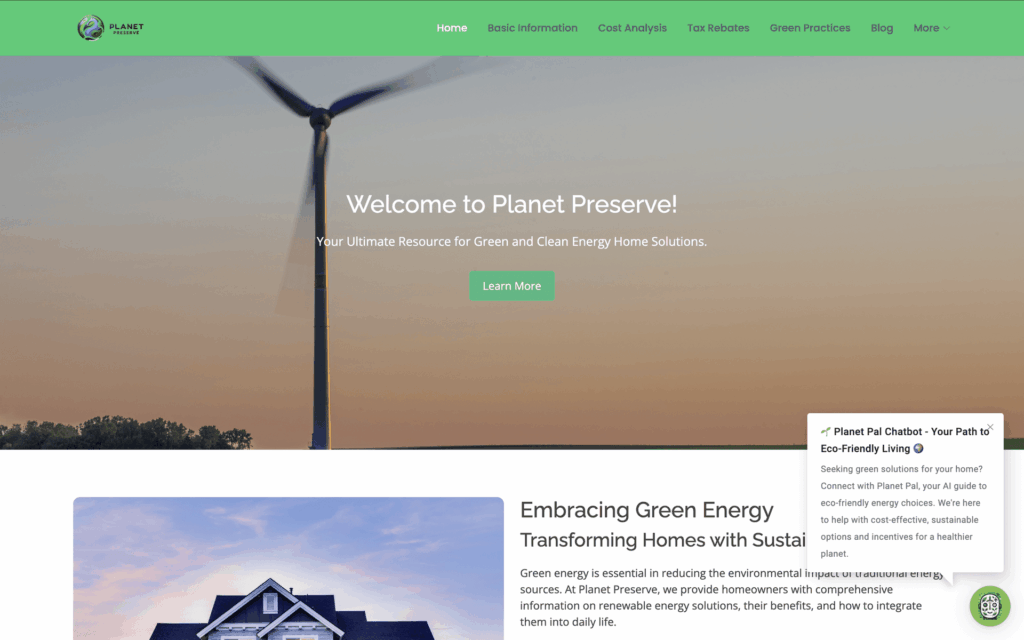Planet Preserve

Project Overview
Planet Preserve is a fictional educational platform developed for the 2024 Georgia TSA (Technology Student Association) Webmaster competition. The competition theme challenged participants to create an online resource dedicated to promoting green and clean energy solutions for homeowners. Planet Preserve was envisioned as a trustworthy, accessible destination where users could learn about renewable energy options and sustainability practices. Working collaboratively with a team, I played a major role in designing the site’s structure, developing its core technical components, and crafting a user experience that was both informative and engaging. Planet Preserve was recognized as a Finalist at the 2024 Georgia TSA State Leadership Conference.
Background & Context
The 2024 TSA Webmaster competition specifically called for the development of a “Resource for Green and Clean Energy Home Solutions.” This directive provided a clear, real-world framework for our project, emphasizing practical sustainability over abstract environmental concepts. Our team immediately gravitated toward the idea of building a user-focused educational site that simplified complex energy topics for everyday homeowners. Planet Preserve was designed to demystify renewable energy technologies, highlight their environmental and economic benefits, and encourage greater adoption of sustainable practices.
Goals & Objectives
Our primary goals for Planet Preserve included:
- Delivering clear, accurate information on various renewable energy sources.
- Designing a visually welcoming and easy-to-navigate interface.
- Ensuring mobile responsiveness and accessibility compliance.
- Offering tools like cost calculators and rebate information to drive actionable insights.
- Creating a polished, professional web presence that could stand alongside real-world environmental organizations.
Planning & Design Approach
The planning process began with a deep dive into existing environmental education websites, renewable energy advocacy platforms, and government sustainability resources. We studied how they structured information, designed user journeys, and balanced technical depth with readability.
Based on this research, we outlined Planet Preserve’s content categories: Solar Energy, Wind Energy, Geothermal Solutions, Energy Efficiency Tips, Rebates and Incentives, and a Blog featuring sustainability news. We also planned to incorporate interactive elements to make the experience less passive and more engaging.
For visual design, we selected a calming, earth-toned palette dominated by greens and soft blues, complemented by clean typography and plenty of white space. The goal was to create an atmosphere of trust, credibility, and optimism.
Wireframes were created for all major page templates, focusing on intuitive navigation, prominent calls to action, and content clarity. We mapped out user flows to ensure that visitors could easily find the information they needed without feeling overwhelmed.
Development & Implementation
We built Planet Preserve using HTML5, CSS3, JavaScript, and the Bootstrap front-end framework. Bootstrap enabled us to rapidly prototype and deploy a responsive, mobile-friendly layout while customizing components to fit our branding vision.
I led much of the front-end development, ensuring that the site’s structure adhered to accessibility standards such as appropriate color contrast, keyboard navigation, and meaningful alt text. Special attention was given to performance optimization, with compressed images, minimized code, and fast load times.
One of the unique features I implemented was a cost calculator that allowed users to estimate potential savings from installing solar panels. This interactive tool served to personalize the content and encourage users to take real-world action.
Throughout the project, collaboration and version control were critical. We divided responsibilities based on individual strengths, held daily progress meetings, and regularly merged updates to maintain consistency and momentum.
Key Features
Planet Preserve integrated a variety of features to maximize its educational impact:
Comprehensive Educational Resources: Each renewable energy source had its own dedicated section explaining how it worked, its benefits, and common considerations for homeowners.
Cost Analysis Calculator: An interactive tool where users could input basic home data to receive estimates on installation costs, savings, and environmental impact.
Rebates and Incentives Guide: Up-to-date information on federal and state programs offering financial support for green energy adoption.
Sustainability Blog: Regularly updated articles covering eco-friendly home tips, green technology news, and environmental success stories.
Responsive and Accessible Design: Built with a mobile-first approach, ensuring the experience remained consistent and accessible across devices.
Outcomes & Achievements
Planet Preserve was recognized as a Finalist at the 2024 Georgia TSA State Leadership Conference, standing out for its user-centric design, breadth of information, and professional presentation. Judges praised the site’s clean structure, interactive elements, and ability to translate technical topics into approachable content.
More personally, the project solidified my skills in building user-focused educational platforms, integrating interactive tools, and managing accessibility in real-world web design. It also demonstrated the power of collaboration, as each team member’s contributions were essential in bringing the project to life.
Reflections & Learnings
Working on Planet Preserve reinforced the importance of clarity and empathy in design. Educating people about sustainability is not just about providing facts — it’s about making complex systems understandable, relatable, and actionable.
Technically, the project allowed me to deepen my experience with Bootstrap, responsive layout techniques, and client-side JavaScript functionality. I also gained a greater appreciation for accessibility standards, ensuring that information is available to all users, regardless of ability.
If I were to continue building Planet Preserve today, I would explore integrating real-time energy calculators, interactive webinars, and personalized dashboards to make the platform even more powerful and engaging.
Planet Preserve remains a proud example of how thoughtful design, strong technical execution, and a commitment to environmental stewardship can come together to create a meaningful and impactful digital experience.
Description
2024
Developed an eco-focused educational website promoting green and clean energy solutions for homeowners. Planet Preserve was selected as a Finalist at the GA TSA SLC 2024 Webmaster competition. Features include a chatbot for eco-living advice, dynamic resource blogs, and interactive green living solutions — all designed with clean UI and user-first principles.